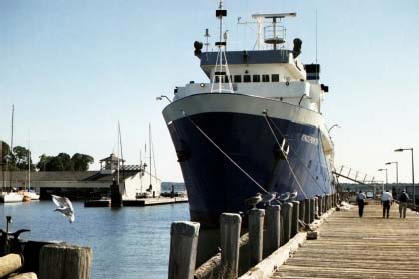|
"The need for medical care has been a
constant since the day the first merchant ship sailed centuries ago.
Concern for the health of merchant mariners has, from the beginning,
been a part of our nation’s history. In the 1700’s, legislation
mandated that a Medicine Chest be carried on each American Flag vessel
of more than 150 tons, provided it had a crew of ten or more. By 1798,
a loose network of marine hospitals, mainly in port cities, was
established by Congress to care for sick and disabled American
merchant seamen. Called the Marine Hospital Service, later the Public
Health and Marine Hospital Service, and finally the Public Health
Service, these federal entities continued to provide healthcare to
merchant seamen until 1981.
The Ship’s Medicine Chest and Medical
Aid at Sea has been a part of much of this
maritime history. This edition has evolved through many previous
editions. The Public Health Service published the first Medicine Chest
in 1881 under the title, Handbook for the
Ship’s Medicine Chest.
The early editions of the Medicine
Chest provided step-by-step instructions on how to treat a variety of
illnesses that might be expected underway when the ship was days from
shore, and had limited communication with land. The master or
designated crewmember had to independently manage whatever injury or
illness might occur.
Fortunately, for the health of all
merchant seamen and others at sea, the world has changed. Modern
technology allows for nearly continual “real-time” communication
between the ship and shore. With this, real-time access to medical
consultation is nearly always available. In today’s world, serious
medical problems underway will be managed via communication with
shore-based physicians and other medical resources. More sophisticated
tele-medicine capabilities, often including video as well as audio
components, are also continually being expanded.
As a result of these changes in
technology and medical practice, this edition has limited the “how to”
aspects of medical management. Instead, it identifies when medical
consultation may be needed, and describes how to do a basic physical
exam and then how to communicate these medical findings to shore-based
experts. As in any aspect of treatment or consultation, effective
communication is key to quality healthcare." |

"Another
focus of this edition is prevention. Prevention, of both acute and
chronic disease, will improve the quality of the merchant mariner’s
life while at sea, and also many years into retirement. Prevention
will also maximize the productivity of the crew and its ability to
meet its missions.
The edition, like past editions, has
many audiences. The appendices on U.S. Coast Guard health capability
requirements will be of particular value to merchant mariners. Much of
the public health information has a much broader audience, and will be
of value to those with private craft as well. Where possible, websites
have been provided to assist in reaching additional reliable resources
of information.
Ensuring your health and safety, as our
merchant mariners, is a priority to all of us who greatly benefit from
your service – we thank you for what you have and will do for America!
And may you have fair winds and following seas…."
Continue...
This photograph was
taken at the U.S. Merchant Marine Academy, Kings Point, New York by James A.
Calderwood, Jr.
|
